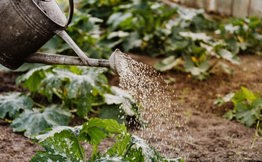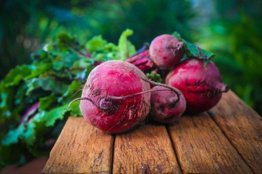Professional guide: preparing ornamental gardens for the shemitah year
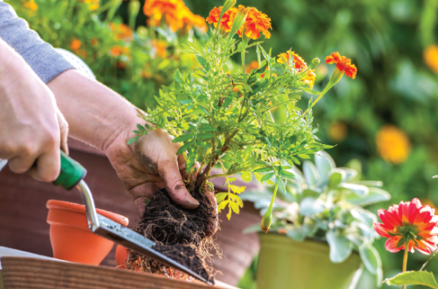
How should professional and private gardeners prepare for the shemitah year?
See here for the PDF version, which includes pictures.
Introduction
Engaging in the beautification of Israel's landscape is an integral part of the mitzvah of settling the Land of Israel. Gardening in Israel is substantively different than gardening abroad. In any other country, the purpose of ornamental gardens is simply to give people a sense of calm and expansiveness and to allow them to enjoy beautiful sites. In Israel, in contrast, the engagement in the beautification of the landscape, which endears the land to its inhabitants, is a value in and of itself. Enhancing the mitzvah of settling the Land of Israel by increasing its aesthetic nature is praiseworthy, indeed.
For this reason, we need a break for one year. A year of rest for man and soil brings anyone who treads the ground to encounter Yehoshua bin Nun upon his entrance to the Land of Israel, when an angel commands him: "Remove your sandals from your feet, for the place where you stand is holy" (5:15). Nevertheless, this sabbatical is not intended to revert the land to a state of chaos and fill every garden with thorns and brambles. Abstaining from certain activities, while knowing that performing other activities depends on halachic questions and requires clarification, brings this awareness to life for each gardener and homeowner. And the sanctity of the Land of Israel lives on in the hearts of all.
This guide was written for professional and private gardeners; what is true for farmers is not necessarily true for gardeners. Farmers deal with food—vital staples for basic sustenance; gardeners are involved in matters perceived as luxuries. For this reason, halachic rulings for farmers differs from rulings for gardeners. Here we do not search for the lenient opinions to rely on in extenuating circumstances; rather we looking for the conventional, straightforward halachic guidelines—whether stringent or lenient. This is where the differences in halachic guidelines stem from.
Chapter 1: Halachic Principles
- According to the guidelines of the Chief Rabbinate, we should not employ heter mechirah to sell the land to a non-Jew for private gardens (since this is not considered she'at hadechak, extenuating circumstances[1]). This necessitates proper advance preparations during the sixth year, so that we can enjoy our ornamental gardens during shemitah year and following it.
- The activities forbidden during shemitah include: plowing, sowing, pruning, grain harvest, and grape harvest (in commercial quantities). Also planting (trees or other plants) and watering sprouts are all forbidden, along with engaging in commercial activities with shemitah
- All other activities that encourage growth are also forbidden, unless they are vital to preserve the plants and to prevent damage in coming years.[2]
- Non-agricultural landscaping activities, such as: paving roads and sidewalks, digging channels for pipes, etc., may be performed as usual during the shemitah year, with certain restrictions[3] (especially vis-à-vis dirt work).
- Gardens in joint courtyards: each Jew is responsible for remitting their land. Even if others work one's land, one nevertheless transgresses the biblical commandment of remitting the land. Furthermore, it is forbidden to participate in funding prohibited gardening activities. For this reason, it is best to try to convince other tenants in joint living areas (apartment buildings and such) that it is possible to properly tend to the joint ornamental garden during the shemitah year while following halachic guidelines. If others remain unconvinced, avoid fighting with them; rather, ask a competent halachic authority on how to proceed.[4]
Likewise, it is permissible to rent out a house or apartment to non-shemitah [5] - The halachic restrictions apply also to professional gardeners and to gardening contractors who make a living from gardening activities. If organizations and institutions require such professionals to perform prohibited activities during the shemitah year, they should consult with a competent halachic authority.
Landscape development contractors should also ask for specific guidance regarding activities that may be performed when developing a garden during the shemitah Take into consideration that many landscaping activities are prohibited during this time.
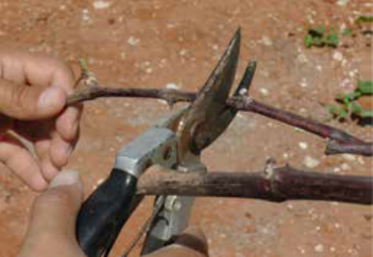
Pruning
Chapter 2: Preparing the Ornamental Garden for Shemitah
Planting trees and other plants
- Fruit trees: (1) Bare-rooted saplings, or (2) saplings encased in a clod of soil that crumbled during the planting process, and (3) trees transplanted without a clod of soil sufficient to sustain it for two weeks: such trees should be planted until 15 Av before sunset. This allows them two weeks to take root plus an additional month afterwards. This extra month makes it possible to count the last month before the onset of the shemitah year as an entire orlah year for the tree.
Fruit trees rooted in a clod of soil in a perforated pot (with a perforation the diameter of at least 2.5 cm) prior to 15 Av, which stood on the soil before 29 Av (so they are considered connected to the ground), can be planted until Rosh Hashanah. This is provided that the clod of soil encasing the roots does not crumble during the transplant.
If the clod crumbles, the tree must be uprooted. A fruit tree sapling growing in an unperforated pot, or in a nursery placed on a sheet that separates it from the ground, may be planted until 29 Av.
- Non-fruit trees and ornamental plants: If planted in a clod of soil (see above), and there is no concern that the clod will crumble, they may be planted until Rosh Hashanah.
- Non-fruit trees and ornamental perennials, not subject to orlah laws, which are bare-rooted or when there is a concern that their clod of soil will crumble upon transplant, may be planted until 15 Elul (such plants may not be watered after Rosh Hashanah so that they will take root, if they haven't taken root by that time).
Annuals should be planted or sown by 26 Elul and watered immediately.
- Edible plants – whether edible for humans or animals, which took root during the shemitah year, are forbidden to eat. They should be uprooted.
- Optimally, lay turf by the spring before the shemitah year so that the grass will have enough time to cover the area before Rosh Hashanah. This is vital so that mowing the lawn during the shemitah year (which spurs horizontal grass growth) will not cause the grass to spread out and cover bald spots.
Planting (laying) turf should be completed several weeks before shemitah so that the grass will properly take root and it will be possible to mow it prior to the shemitah
Other plants as well (such as trees, bushes, roses, perennial flowers, etc.) should be planted enough in advance of shemitah so that they can grow and mature as much as possible during the sixth year. The more mature the plant, the less shaping, pruning, fertilization, and weeding care will be necessary during shemitah. - Instead of seasonal plants generally planted in large quantities to create colorful effects, perennial or biannual flowers can be planted before shemitah, which will grow and flower during the shemitah Such perennials include: geranium (pelargonium), common snapdragon, gazania, chrysanthemum, coreopsis, various types of sage, perennial grains, and many others.
It is also possible to plant geophytes (bulbs) before Rosh Hashanah, which will flower during the shemitah year. As mentioned above, they can be planted (and take root) before Rosh Hashanah. Those planted right before Rosh Hashanah will take root following rainfall, and flower from autumn to winter. It is possible to regulate flowering throughout long seasons by refrigerating some of the bulbs, which encourages early flowering. Taking root can be sped up by advanced storage in refrigeration on a moist growing platform. Flowers that can be sown before shemitah as bulbs include: anemone, gladiolus, iris, narcissist, cyclamen lily, amaryllis (hippeastrum), and buttercups, among others.
- Temporary turf: it is possible to plant Lolium varieties (annual ryegrass) approximately three weeks before Rosh Hashanah, water and sprout the lawn, and receive an effect of a green lawn for the duration of the shemitah year. This option can serve as a solution for those who did not get a chance to lay permanent turf during the sixth year; or, alternatively, if such turf was supposed to be laid the following year, following the work plan. In the latter case, this turf will serve as a temporary substitute for permanent turf. For such cultivars, growth does not occur with horizontal extensions, so mowing does not cause the lawn to spread out. Such turf can also fill in bald spots ahead of Rosh Hashanah.
Note that the only leniency to prepare plants during the shemitah year in nurseries applies to plants grown on detached platforms, under special conditions. These conditions do not exist in most nurseries, so they generally prepare plants and saplings during the sixth year. For this reason, it is important to order saplings in advance from nurseries for the eighth year to allow them to duly prepare during the sixth year. If nurseries prepared plants during shemitah in a forbidden fashion, it is forbidden to purchase plants from them during the eighth year.
Chapter 3: Pruning Before Shemitah
We may not prune mature trees and bushes during the shemitah year. For this reason, it is recommended that we fully prune all plants in need of pruning during the sixth year. Tree pruning should be performed, professionally as detailed below:
- Genuine deciduous trees (from the temperate or Mediterranean Sea regions) that shed their leaves in early winter, including: ash, Mt. Tabor oak, common almond, Chinese flame, and other rosaceae fruit trees. Such trees, when pruned on time when they shed their leaves in the winter, can be pruned at the end of summer and autumn (before shemitah) to avoid the need to prune them again during shemitah.
- "Forced" deciduous trees (trees that do not shed their leaves in their indigenous climate, which is warmer, but shed leaves in our relatively cooler climate) include: North Indian rosewood, royal poinciana, tipuana tipu, jacaranda (fern tree), yellow poinciana (peltophorum), Albizia lebbeck (acacia tree), among others. Such trees should be pruned in early summer of the sixth year. Mostly evergreen trees, including: ficus, common oak, Syrian maple, and olive, etc., should be pruned accordingly. If there was not enough time to prune them during this time, it is also possible to prune in late summer when the heat wanes.
Pruning to correct branch extensions and other shape corrections should be performed throughout the summer preceding shemitah.
- Conifers should be pruned during autumn, preceding Rosh Hashanah.
- Pruning young trees: intense shaping work should be performed on young trees prior to shemitah to reduce the need for pruning during the shemitah The more mature and professionally shaped the tree, the simpler it will be to tend to during the shemitah year from a halachic perspective. We recommend purchasing shaped trees in the nursery with 2–3 branches. This will make it possible to avoid shaping the tree during shemitah.
- Pruning bushes: from a professional perspective, no damage will occur to these plants or to their appearance if they are not pruned for one year. For this reason, in most cases there is no heter to prune bushes during In light of this, professional pruning should be performed prior to the shemitah year. Non-professional pruning can cause undue damage to bushes and trees. Regarding tending to living fences during shemitah, see below (Chapter 3, §5).
- Pruning rosebushes: precise pruning performed prior to shemitah will make it possible to forego winter pruning during shemitah without damaging the rosebush whatsoever. Those who gradually prune (known as katif yored) throughout the summer of the sixth year will not need pruning during Katif yored is gradually pruning lower and lower each time. In this way, the bush is trimmed until the end of the summer so it will be lower before the onset of the shemitah year.
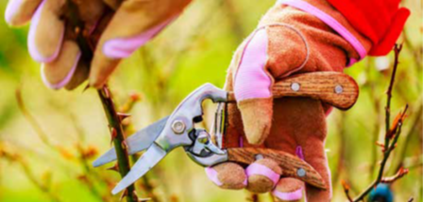
Pruning rosebushes
- Supporting and tying trees and branches should be performed before
- Forest thinning should be performed in autumn prior to shemitah.
- Painting tree trunks ahead of the winter and actions performed to protect from the cold (wrapping, etc.) should be performed prior to shemitah as much as possible.
Chapter 4: Fertilization, Weeds, Lawns, and Preparing for the Eighth Year
Fertilization
- To avoid fertilization as much as possible during the shemitah year, fertilizer should be applied in the autumn prior to shemitah to young trees and bushes, lawns, rose bushes, flowers, and grassy cover plants. Such fertilizer should include phosphorous (superphosphate 50g per m2) and potassium (potassium chloride, 30g per m2).
- Heavy and moderate soils should also be fertilized with nitrogen (ammonium sulfate, 20g per m2). For sandy soils, the autumn fertilization with nitrogen is important, and it is possible that fertilization will be necessary during shemitah (due to runoff during the winter). In large gardens, it is recommended to supplement the amounts of fertilizer necessary based on soil tests.
Alternatively, it is possible to use combined fertilizers that included the three above elements and microelements (such as Deshen-Kol 20-20-20. If using this fertilizer, apply 20g per m2).

Compost
- Another possibility is to use compost or combined fertilizers to slowly release nutrients in the soil, to be applied before Rosh Hashanah. Such fertilizers can release nutrients vital for plants throughout the shemitah Compost should be applied 5L per m2, while slow-release fertilizers (SRF) should be applied according to the manufacturer's instructions (request combined SRF that includes nitrogen, potassium, and phosphorous, to be released over the course of the year). Today there are SRFs available that release nutrients over a 12-month period, which can nourish plants for a long time.
Weed treatment
Meticulously weed the garden prior to the shemitah year to avoid unnecessary weed treatments (such as spraying) during shemitah. It is possible to use soil sprays during autumn (on weed-free soil) with chemicals that prevent weed growth (pre-emergence herbicide), watering them into the soil. Such pre-emergence herbicides can stay in the soil for a long time and can harm certain crops. For this reason, opt for herbicides that remain active during the winter of shemitah, but not any longer. Such herbicides include: Stomp, Ronstar, and Goal. If the area in question is clear of plants and weeds, and is not intended for future plant growing, it is possible to use a combination of Alion and Diurex. Application of such herbicides leaves the area weed-free for a longer period of time. Ensure they do not run off to adjacent areas. In any case, it is important to closely follow the manufacturer's instructions to prevent damage to other garden plants.
It is also possible to spray the edges of the lawn with contact herbicide, such as Roundup (or other glyphosates), Deganol, and others. Appropriate herbicides can be effective for several months. Another method, without using chemical substances, is covering the ground with nylon sheets and spreading Palrig on top of them.
Lawn care
Perform all activities, when possible, during the sixth year so they can be avoided during shemitah. These include: lawn thinning, aeration, and fertilization, among others.
Preparing clear areas during the sixth year for gardening during the eighth year
It is best to perform various activities during the sixth year to facilitate planting the new garden immediately following shemitah, for example: chemical soil sterilization or soil solarization against pests and weeds; multi-year herbicide during the summer; deep tilling to enhance and aerate the soil, and more. Performing these activities during the summer will make it possible to plant the garden immediately after the end of the shemitah year during autumn; it won't be necessary to wait until the spring following shemitah.
Vegetable gardens (community gardens)
To enjoy vegetable gardens during shemitah, prepare for planting or sowing appropriate crops during the sixth year. It is possible to plant winter crops, such as onions, kohlrabi, and such. In this way, the garden can be enjoyed during the winter of shemitah.
Crops with long growing periods (such as potatoes and carrots) can be planted in the late summer preceding shemitah and can be enjoyed for a long period of time. It is also possible to bury onion sets in the ground, and the like, prior to shemitah so they will sprout following the winter rains and continue growing for an even longer period. Plant such vegetables by 15 Elul before shemitah. If the plants come with a clod of soil (Hishtil trays), they can be planted until right before Rosh Hashanah. Of course, only their basic growing needs (such as irrigation) can be tended to during the shemitah year, without fertilization or growth stimulators.
Throughout the shemitah year, receive guidance from a competent halachic authority about the activities that may and may not be performed in the garden. Note that the crops growing during the shemitah year have shemitah sanctity and are ownerless; one should not prevent others from harvesting them.
An additional solution is to build a small hothouse with detached platforms. In such hothouses, the laws of shemitah do not apply under specific halachic parameters, and all agricultural activities are permissible. This hothouse should be at least 80cm high, with completely waterproof material separating it from the ground, a roof, and four walls. The ground should be prepared with a slight decline to prevent pools of water from forming. The ground should then be covered with a strong nylon sheet with a black Palrig sheet on top.
During the winter, the roof of the building and two walls should be made of nylon. The other two walls should consist of hothouse nets to facilitate airing out the hothouse. During the summer, it is possible to replace the nylon roof with two 50 mesh nets placed one on top of the other. If needed, another net can be placed on top to provide shade. The ground of the hothouse needs to be clear of dirt throughout the entire shemitah year. In such hothouses, it is possible to grow plants that are no larger than 60L throughout the shemitah year. Since there are many additional details that are not connected to these halachot, consult a halachic authority before building such a hothouse.
Conclusion
Proper preparation of ornamental gardens ahead of shemitah contributes to the garden's proper maintenance during the shemitah year, under halachic guidelines. Our past experience teaches us that proper planning and organization, as well as changing budget priorities, facilitate optimal tending to ornamental gardens during the shemitah year. It is possible to move back tree planting to the sixth year and allocate the budget for inanimate landscaping (installing benches, playgrounds, exercise facilities, pergolas, fountains, etc.) for the shemitah year. In this way we will enjoy a relatively well-kept garden while meticulously observing halachah.
[1] Iggerot HaRa'aya (I §177, §198); Rabbi Herzog (Rulings and Writings, Zera'im §31); Betzet Hashanah (p. 31 §12, p. 46 §1–2).
[2] Shabbat Ha'aretz (1:5 and Kuntres Acharon §12). The source for the leniency of ukmei (performing activities for the purpose of preservation and maintenance) for ornamental plants is the Mabit's responsa (II §64), which addresses watering flowers. See also Shabbat Ha'aretz (Kuntres Acharon, ibid.); Rabbi Shlomo Zalman Auerbach (Kerem Tzion chap. 4, Gidulei Tzion §6 and the end; Ma'adanei Eretz §8:8; Minchat Shlomo §51:8); Responsa Mishnat Yosef (I §8, II §9–10); Shevi'it LeHalachah VeLema'aseh (p. 31, n. 3).
[3] Non-agricultural activities are permissible, under the following conditions:
1. Their purpose is not agricultural.
2. It is obvious to others what the purpose of the action is according to the way it is performed or its context.
3. If the matter in question is a biblical prohibited activity, such as pruning, it should be performed in a way that is not helpful to the plant, or at least in a way that it not optimal for the plant. See Shabbat Ha'aretz (1:18 §5, 20 §3; 2:8 §1).
[4] Every Jew is commanded to remit their land during the shemitah year and not allow others, who are obligated in mitzvah observance, to work it either: see Shabbat Ha'aretz (1:1 §1). To avoid transgressing this prohibition, Rabbi Shaul Yisraeli ruled that under these circumstances, one may apply to the Chief Rabbinate to sell one's portion of the garden to a non-Jew. Rabbi Shlomo Zalman Auerbach (Ma'adanei Eretz §13, Kovetz He'arot §8:3; Minchat Shlomo §41:3) ruled that one should declare one's portion of the garden ownerless in the presence of three people. Since selling a portion of joint property or rendering it ownerless raises legal issues, Rabbi Bakshi Doron suggests rendering one's portion ownerless and requesting that the HOA (Home Owners' Association) sell the entire garden to a non-Jew.
Rabbi Shlomo Zalman Auerbach (Introduction to the booklet Tipul Began Hanoy [tending to the ornamental garden], published by the Institute for Agricultural Research According to the Torah – Emunat Ish, 5732), rules that even if the HOA will use the funds to commission prohibited gardening during shemitah, it is permissible to pay the fee since it is a legal obligation; it does not necessarily constitute participation in prohibited activities. Rabbi Mordechai Eliahu advises paying the HOA fee as a lump sum, including the payment for other HOA expenses (thus considered havla'ah, lit. "swallowed up"), so the money will not go to the prohibited gardening activities but to other things (electricity, cleaning the building, etc.). His sources include Mabit (II §64) and Maharit (II §53).
[5] See Ma'adanei Eretz (§ 13); Kerem Tzion (chap. 1, Gidulei Tzion §3); Shabbat Ha'aretz (8:6 §7).



